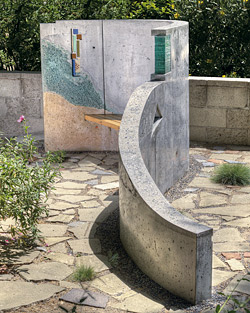 There’s one key point on which architects and decorative concrete contractors agree: “The architect needs to have a contractor who knows what he’s doing,” says Marley Porter, AIA, who operates Living Architecture & Construction Management, located in Texas Hill Country at Cottonwood Shores.
There’s one key point on which architects and decorative concrete contractors agree: “The architect needs to have a contractor who knows what he’s doing,” says Marley Porter, AIA, who operates Living Architecture & Construction Management, located in Texas Hill Country at Cottonwood Shores.
Porter, who owns an extensive portfolio of decorative concrete work, says the DC contractor had better be able to demonstrate more knowledge than Porter has about the trade and the technology, “or he’s not going to get the bid.”
Porter doesn’t mince words in his frank views on the decorative concrete trade and what might improve designer-contractor dealings.
“A lot of people shouldn’t be doing it, thinking it’s quick money,” he says flatly. “Don’t oversell yourself and make sure you know what you are doing. And make it clear that when you make a mistake you’ll fix it.”
Porter says he’s heard too many contractors say, “This goes down once and that’s what you get.” That won’t fly if the contractor is looking to build the business long-term.
“Know what everybody’s expectations and limitations are of the materials, and be willing to step up to do what it takes to make the client happy,” he says.
A sampling of opinion from Porter and several other architects produces a variety of observations on what they take away from their work with decorative concrete contractors — and, in a more perfect world, what contractors might bring to the table. Some of these wishes are highlighted in the following list of five.
1. Stay in sync with the designer’s plan.
Architects are chagrined when decorative concrete contractors take liberties in a project design, going in a direction that may be out of sync with the design plan.
Perhaps the contractor has failed to consult with the designer on what Porter calls the “philosophy of the design,” instead becoming infatuated with decorative elements such as a sunburst or compass that don’t belong.
“Sometimes concrete subs will go directly to the owner — quite often they fancy themselves as artists, or maybe they indeed are artists,” Porter says. “But when they do that after the design of a home is worked out and agreed to with the owner, sometimes down to the exact score cuts in the concrete, you can end up with a pile of ‘cute’ little concrete curiosities that have nothing to do with the project.”
Claudia Humphrey, project designer with Heath Design Group, in Baltimore, also cautions against detouring from the specified design. If a scale, pattern, offset or other specification is noted in the plans, it shouldn’t be available for revision unlesss there is a catastrophic discovery during demolition that completely prohibits the installation, Humphrey says.
The same goes for color, she says. “Pigment is key. If a design specifically identifies Pantone colors, or a specific matrix of colors to match a brand, logo (or other element), substitutions are not accepted.”
“The best concrete subs are those who carefully work with the architect or designer with their own expertise and experience to maintain and enhance the design motif,” Porter says.
2. Do less decorative concrete.
“When finishing decorative concrete, take a minimalist approach,” proposes David Eaves, AIA, of LPA Inc.’s Irvine, California., office. “Generally, architects are looking for consistency more than perfection. Particularly with decorative concrete, perfection is nearly unattainable. Therefore, focus on consistency in execution using the same mix, placement methods, cut or grind, polish, etc., as performed during the mock-up phase.
“This starts by doing less. The less concrete is worked, ground, polished, and so on, the more likely we are able to achieve consistent results. We understand that it often takes a tremendous amount of work to ‘do less,’ and all the preparation effort will be worth it and appreciated in the final product.”
Aleksander Tamm-Seitz, senior project designer with Morphosis Architects Inc. in Culver City, California, gives this take on the “less” theme: “One of the main things our office tries to explain to contractors at the beginning of each job is that we aren’t always looking for ‘decorative’ concrete in the traditional sense. What we mean by decorative, or architecturally exposed, concrete is something that still looks like standard concrete, just with a higher level of care applied to it. We aim for truth to materials which, in this case, is really just a nicer version of standard concrete.”
This approach can extend to flaws, Tamm-Seitz says. “Minor cracking can be OK. All concrete cracks. Often there is a desire by contractors and engineers to overcompensate for this. They do it by providing a huge amount of control joints and breaks for cracking. This can sometimes be overkill because visually, control joints can be more objectionable,” he says. “It’s important to acknowledge that some minor cracking may occur, and that this is acceptable, and actually preferred, to large amounts of control joints.
“Once again, this idea of truth to materials and allowing the material to be what it wants to be comes into play for us.”
3. Plan and schedule proactively.
“You only get one shot at it,” Eaves says. “One of the benefits, and also challenges, of decorative concrete is that the structural slab or wall is also the final finish. This requires that careful planning be performed to achieve the desired end result.”
“It’s permanent, or at least expensive to modify if not done right,” notes Porter.
“Recognize that materials, stencils (and other tools) may be longer lead-time items,” says Humphrey. “It’s not always evident during the design process that a vendor may develop a backlog for production of specific stencils. Be proactive about scheduling, since the elaborate designs that require this coordination are frequently feature components to the design and should not be left until the last minute or be a reason for delays to the project.”
4. Maximize the attention to mix design, in part by using more mock-ups.
“Mix designs must be carefully considered and reviewed, paying attention to aggregate and sand type, size, color and sourcing,” says Eaves. “Consistency is critical.”
“On many projects, there will be numerous mix designs, (for) slabs on grade, elevated decks, walls and so on, and achieving consistency is a challenge,” Eaves says. “Mock-ups need to be prepared to review the different mix designs and levels of concrete finishing proposed, for the architect, contractors, and most importantly, the owner.
“Mock-ups establish the expectations for the finished product, and so shortcuts here should be avoided. The more mock-ups performed, the more likely the team will be able to repeat the quality and level of finish with the final placement. Prepare, prepare, prepare and then execute.”
“The mix design is very important,” says Tamm-Seitz. “Many times we grind and polish our concrete floors, and in such cases, the type, size and color of the aggregates being used strongly influences the appearance of the final product. Sometimes it can be acceptable to switch out a mix design during construction structurally, but if all the characteristics of the mix are not considered, the final appearance of the concrete can be quite different from what was anticipated.”
5. Protect the finished product until construction is complete.
“No matter when the concrete is placed on-site, once it is there, protection, care and due diligence must be used,” says Tamm-Seitz. “Careful sequencing in construction can help some of this, but in the end protection at all stages of construction is critical. There is nothing more frustrating than stripping a form or seeing a finished slab pour turn out near perfect, only to have that same concrete damaged later on during construction.”
Structural slabs might be the final exposed floor surface, or a topping slab might serve that purpose. But in the field, the same care and due diligence should be used, Tamm-Seitz says.
For Porter, a proactive attitude toward protection extends to proper sealer application. “One problem I see is proper cleaning of floors,” he says. The contractor didn’t “get down on their hands and knees” to clean the floors, figuratively speaking, “and when you put a sealer on it the problem is retained in perpetuity. Mop it five times, not two.”
















